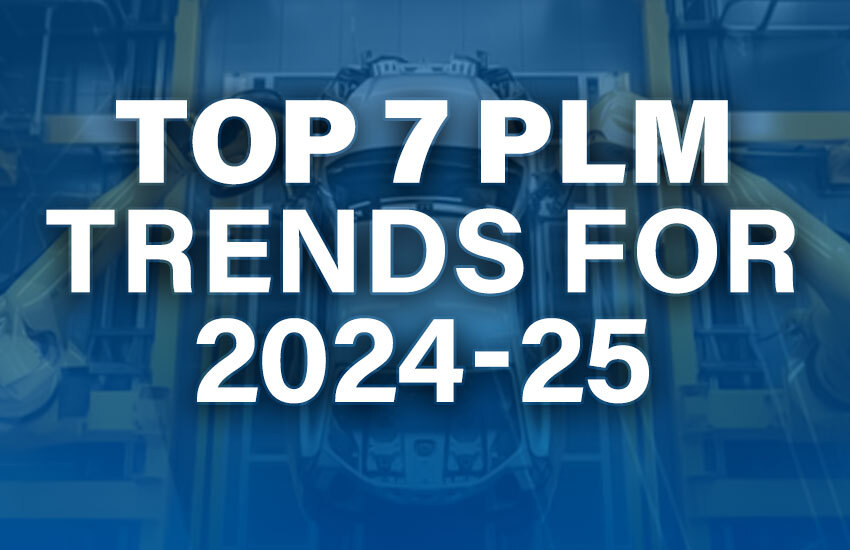
Product lifecycle management (PLM) is the strategic business process of managing a product's entire lifecycle, from its conception, design, and development to its manufacturing, production, and service. PLM software helps companies streamline product development processes, improve collaboration between teams, and reduce costs.
In today’s fast-paced industrial landscape, the importance of effective Product Lifecycle Management (PLM) cannot be overstated. As we step into 2024-25, various trends are reshaping the PLM landscape, driving innovation, and offering businesses new ways to optimize their product development processes. In 2024-25, we see a focus on digitalization, cloud-based solutions, and emerging technologies like artificial intelligence (AI) and machine learning (ML). These trends are transforming the way companies manage their product lifecycles and are driving innovation across industries.
In this blog post, we will explore the top 7 PLM trends for 2024-25 and discuss what's driving innovation in the PLM space.

Cloud deployment is one of the most significant trends in PLM today. Cloud-based PLM solutions are gaining traction because companies seek to improve accessibility and collaboration. The shift to cloud infrastructure allows teams to work seamlessly from any location which enhances productivity. A report from a recent survey shows that, 70% of organizations have shifted to cloud-based solutions for their PLM needs, with the best PLM software for manufacturing often being hosted on the cloud.
Scalability: Cloud solutions are scalable. They can grow with your organization.
Cost-Effective: Reduced upfront investment and maintenance costs as Cloud deployment eliminates the need for upfront hardware and software costs..
Accessibility: Cloud-based PLM systems can be accessed from anywhere with an internet connection.
Security: Cloud providers offer robust security features to protect sensitive product data.
The increasing adoption of cloud-based PLM solutions is a major driver of innovation in the PLM space. Cloud deployment is making PLM more accessible and affordable for businesses of all sizes. Companies such as Modelcam Technologies offer robust cloud-based PTC Windchill PLM solutions that empower organizations to streamline their operations efficiently.
Artificial Intelligence (AI) and Machine Learning (ML) are rapidly transforming many industries, and PLM is no exception. They are revolutionizing the way businesses approach PLM. By analyzing vast amounts of data, these technologies enable companies to predict trends, enhance product quality, and improve decision-making processes. When AI is incorporated in Windchill PLM features, for instance, it facilitates automated workflows, and reduces manual input; this in turn will minimize errors.
AI and ML are used in PLM for a variety of applications, including:-
Predictive maintenance: AI and ML can be used to analyze sensor data from products in the field to predict when maintenance is needed.
Product design optimization: AI and ML can be used to optimize product designs for performance, manufacturability, and cost.
Process automation: AI and ML can be used to automate repetitive tasks in the PLM process.
The use of AI and ML in PLM is still in its early stages, but it has the potential to revolutionize the way products are designed, manufactured, and serviced. Organizations utilizing AI in PLM report a 30% increase in product quality and a 25% reduction in time-to-market.
Find out how Windchill PLM can streamline PLM processes in various companies, enhance collaboration, and ultimately bring products to market faster in our blog, Accelerate time-to-market by 25% with Windchill PLM!
The integration of AI and ML in PLM software is becoming a competitive necessity, making it one of the best product lifecycle management software options available today.
Sustainability is a core aspect of business strategy, it’s not just a buzzword. As there is increased consumer awareness about sustainability and regulatory pressure, companies are focusing on creating sustainable products. PLM software in Pune and beyond is evolving to help organizations track their environmental impact and optimize resources effectively.
Life Cycle Assessment: Tools to evaluate the environmental impact of products throughout their lifecycle.
Material Optimization: Solutions to minimize waste and improve resource usage.
Companies can enhance their brand reputation by integrating sustainability into their PLM strategies and contribute to a greener planet.
In today’s interconnected digital world, Collaboration is essential for innovation. The best PLM software for manufacturing emphasizes collaborative features that allow teams to work together in real-time, regardless of their physical location. Windchill PLM solutions provide functionalities that support cross-departmental collaboration, breaking down silos and encouraging a culture of teamwork.
Faster Decision-Making: Decision making becomes faster as real-time collaboration leads to quicker approvals and insights.
Improved Communication: As there is enhanced visibility across teams it reduces misunderstandings and errors.
This trend is crucial for organizations looking to innovate rapidly and efficiently. You can explore our blog post, 4 Ways Windchill PLM Services Can Enhance Collaboration Across Teams and learn more about how Windchill PLM can boost collaboration across teams.
Software as a service (SaaS) is a cloud-based delivery model. In SaaS, the software is licensed on a subscription basis. Multi-tenant architecture is a type of SaaS architecture in which multiple tenants share a single instance of the software application.
As companies look for more affordable and easy-to-use PLM solutions, SaaS and multi-tenant PLM solutions are becoming increasingly popular. SaaS PLM solutions offer several advantages over traditional on-premise deployments, including:
Lower costs: SaaS PLM eliminates the need for upfront hardware and software costs.
Faster deployment: SaaS PLM solutions can be deployed quickly and easily.
Automatic updates: SaaS PLM providers automatically update their software, so businesses always have access to the latest features and functionality.
The need for customizable PLM solutions becomes paramount as market demands evolve. Organizations are increasingly seeking PLM software that can be tailored to their specific needs. The best product lifecycle management software solutions offer modular functionalities, allowing businesses to choose features that align with their operational requirements.
Check out our blog, 6 Factors to Consider for a Customized Windchill PLM Experience and find out PLM’s extensive customization capabilities!
Adaptability: Companies can quickly pivot in response to changing market conditions.
Personalization: Tailored features enhance user experience and engagement.
Modelcam Technologies is at the forefront of offering customizable Windchill PLM solutions that can be adapted to a variety of industries and business models.
The Internet of Things (IoT) is reshaping the manufacturing landscape, enabling real-time data collection and monitoring. When IoT is integrated with PLM systems, it allows companies to gain insights into product performance and lifecycle management more efficiently. Windchill PLM enhances operational visibility and enables predictive maintenance when it is seamlessly integrated with IoT devices.
Real-Time Monitoring: Track product performance continuously.
Proactive Maintenance: Minimize downtime by anticipating issues before they escalate.
This trend not only improves product reliability but also fosters innovation by providing valuable feedback for product enhancements.
Navigating the evolving landscape of Product Lifecycle Management in 2024-25 presents both challenges and opportunities. By understanding the above top seven trends, businesses can strategically position themselves for success.
Adopting Windchill PLM - the right PLM software, from Modelcam Technologies, empowers organizations to optimize their product lifecycle management processes, drive innovation, and enhance their competitive edge in a rapidly changing marketplace.
As we look ahead, organizations that embrace these trends will not only improve efficiency but also create more innovative and sustainable products that meet the needs of their customers. The future of PLM is bright, and those who adapt will thrive in this dynamic environment!
Let’s connect: www.modelcamtechnologies.com
Email: sales@modelcamtechnologies.com
Mobile no : +91 8237016167
©Copyright 2025. All rights reserved by Modelcam Technologies Private Limited PUNE.